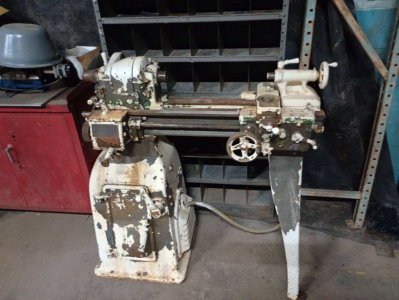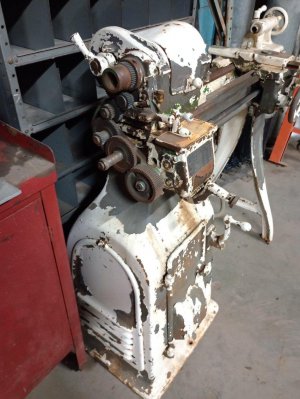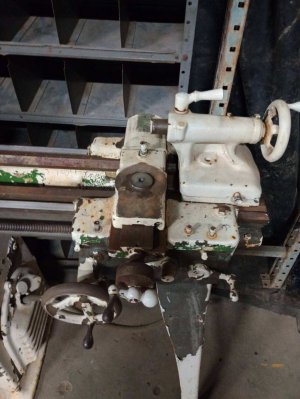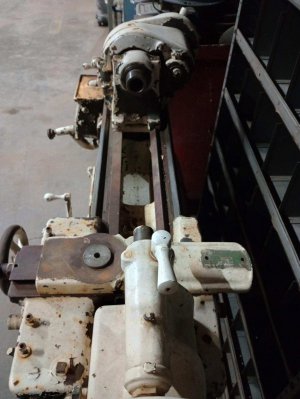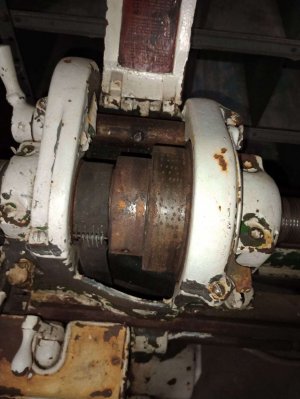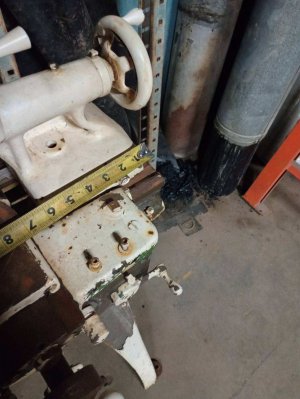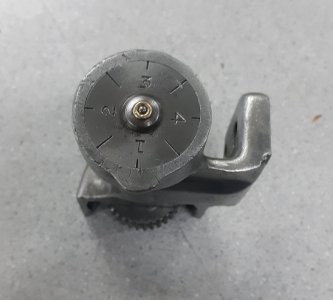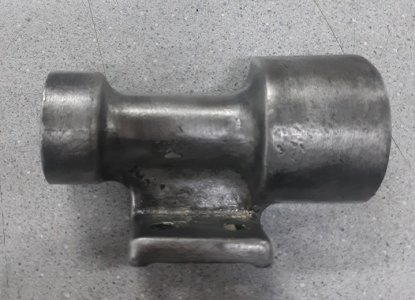- Joined
- Dec 25, 2023
- Messages
- 94
As a new member, I was unsure of where to put this. I did not want to belabor the new member introduction page I had, and while it may have fit in with the Lathe Restoration forum, I think it may also be a candidate for the Goofs and Blunders You Should Avoid forum.
To save on typing, I'll just give you the email I sent to my father, who uses a Unimat Excelsior for turning pens and pretty things:
"... I had to share my excitement with the only other man I know who might get as big a thrill out of it as I did. I've been looking for a metal lathe for literal years, ever since I first had a chance to learn to use one back in 2012. They are amazing machines, as you know, and the only machine that can duplicate itself with the proper tooling and casting.
"I was looking about on Craigslist, and attempting to make contact with one seller who had one he claimed was from the 1880s! It was nothing to write home about, covered in rust and age, but it was complete save a motor, having been originally driven by an overhead flat belt. It appeared to have the option of change gears for the carriage, but whether the gears were there or not I don't know, he didn't have a picture of the left end of the headstock. The trouble was, he was terribly uncommunicative, and seemingly unwilling to work with my schedule- the only day I could come look at it was Sunday, and he was 4 hours away. Most of my emails went unanswered, and those that were answered were terse and gruff, so I gave up and went back to looking.
"As grace would have it, a guy had just posted an ad selling a bunch of tooling equipment. No pictures, no prices, just text, and he mentioned 'metal lathes'. I wrote to him asking if he had anything in the light hobby size, from a 7x14 up to a 12x36 (which is approaching light industrial size). He wrote back promptly and said he had an old 10x30, but it was rough. I asked for pictures, and here's one he sent:
"I couldn't tell from the scale, and could not see any data plates from it or the other pictures he sent, but after a BUNCH of research I learned it's likely an early 1940s South Bend 10L, also known as the "Heavy 10", which was the smallest light industrial unit they made. Just from the pictures I noted the following shortcomings: No faceplate, no chuck, no centers, no toolpost... no compound rest?! Holy crow, how is a guy to use this? The missing bolt in the tailstock indicates an also-missing tailstock clamp (it is). One picture showed the spindle drive belt, but he didn't show the motor, which should be in the base cabinet on the left (it is, but it's three-phase!).
"After going back and forth a couple times, we settled on a price: the princely sum of $225. FOR A SOUTH BEND LATHE! Never in my life would I expect to be able to afford a South Bend, their prowess is legendary in the hobby lathe world, and for so cheap! Most hobbyists use the more common 9 series bench lathes, or the 10K called the "Light 10" (basically a beefed-up 9 with an extra inch of swing). Examples online have prices from a thousand dollars for units looking almost as bad as this one, on up to four or five grand for one fully restored.
"We discussed schedules, and he was willing to meet me after he got home from church Sunday, about 2pm (oh, he's also only 2-1/2 hours away, which helped). Sunday Ivy and I did chores, prepped the truck, and were on the road by 10:30a. We got to his town by 1:30p (I drive slowly in the truck), and he was already there- he'd planned to take his kids out to brunch after church, but all the restaurants were closed- oh, yeah, it's Christmas eve! Whoops. So he got there early to prep the unit, and we got there shortly after.
"He had an AMAZING shop. 21,000 square feet of manly wonder. Metal stock everywhere. A semi tractor with the engine half-disassembled. A full tire and exhaust repair corner. A vertical lathe that probably had a swing of 48", but a "bed" of only the same, with the overhead 'tail stock' making it about eight feet tall, and ten feet around. Lower but longer was a beautiful humongous horizontal lathe, 24x96". He said if he took the tailstock off (with the attached crane used for just that purpose) and fitted it with a bearing-tipped steady rest about the size of your torso, he could spin up a shaft twelve feet long or more. I think the spindle bore was 4". Another lathe in 'gunsmith' size, 16x40". A Bridgeport-style knee mill, a horizontal mill, two 12" shapers, a drill press that had to stand seven feet tall with a Jacobs chuck the size of your fist that went out to 1-1/2". An ironworker that used to be steam-powered but had been converted to run a Wisconsin V4 gasoline engine. I wish I had the presence of mind to take pictures, but we were just in awe.
"And in the middle of it all was this uncharacteristically TINY South Bend "Heavy"! It looked a pipsqueak next to these behemoths. He loaded it into the bed with a forklift, helped me strap it down, and we were on our way about quarter after 2- we'd spent almost 45 minutes talking with the guy about all sorts of stuff and seeing other wonders he had tucked away. On the road we went, and all the way home it didn't budge an inch- it's nice having a truck driver strap your load for you, they really know what they're doing.
"Right now it's still in the bed of the truck, as we got home after 5p and it was dark and raining. I threw a tarp on it and bungeed it down, and we dashed through chores and got in to dry off. I'm on a double shift today, but tomorrow (weather permitting) I'll fire up that beautiful International and use the loader to unload the lathe. I'd like to get it in the basement, but we've had so much rain recently the patio is swampy and I don't want to get the tractor stuck with almost a half-ton load on it. I'll probably set it off on a pallet and tarp it again until I can get down there without needing extraction from a neighbor. To move it about in the basement, I'll also have to bring in my engine hoist- the lathe has no wheels, and it weighs in at a diminutive 860#.
"For now, since I'm still working on the house, plans are just to start collecting parts I know I'll need while we can still get them. I found a factory compound rest minus the original 'lantern' style tool post, but the guy wants more for it than I just paid for the lathe, so after a bit of looking I found a Chinese compound with a more-modern block style toolpost like your Unimat likely uses for $75. I'll need to hunt around for a faceplate, as the 10L has a 2-1/4"-8 spindle thread versus most hobby lathes' 1" or 1-1/2"-8. A 6" chuck should be pretty universal, and I'll need to find a few centers and a Jacobs chuck for the tailstock. I haven't decided whether to replace the motor, or run it with a small variable frequency drive that will convert our house 240v single phase to 3-phase.
"Anyway, Merry Christmas to me! I'm so stoked, I had to share."
1/?
To save on typing, I'll just give you the email I sent to my father, who uses a Unimat Excelsior for turning pens and pretty things:
"... I had to share my excitement with the only other man I know who might get as big a thrill out of it as I did. I've been looking for a metal lathe for literal years, ever since I first had a chance to learn to use one back in 2012. They are amazing machines, as you know, and the only machine that can duplicate itself with the proper tooling and casting.
"I was looking about on Craigslist, and attempting to make contact with one seller who had one he claimed was from the 1880s! It was nothing to write home about, covered in rust and age, but it was complete save a motor, having been originally driven by an overhead flat belt. It appeared to have the option of change gears for the carriage, but whether the gears were there or not I don't know, he didn't have a picture of the left end of the headstock. The trouble was, he was terribly uncommunicative, and seemingly unwilling to work with my schedule- the only day I could come look at it was Sunday, and he was 4 hours away. Most of my emails went unanswered, and those that were answered were terse and gruff, so I gave up and went back to looking.
"As grace would have it, a guy had just posted an ad selling a bunch of tooling equipment. No pictures, no prices, just text, and he mentioned 'metal lathes'. I wrote to him asking if he had anything in the light hobby size, from a 7x14 up to a 12x36 (which is approaching light industrial size). He wrote back promptly and said he had an old 10x30, but it was rough. I asked for pictures, and here's one he sent:
"I couldn't tell from the scale, and could not see any data plates from it or the other pictures he sent, but after a BUNCH of research I learned it's likely an early 1940s South Bend 10L, also known as the "Heavy 10", which was the smallest light industrial unit they made. Just from the pictures I noted the following shortcomings: No faceplate, no chuck, no centers, no toolpost... no compound rest?! Holy crow, how is a guy to use this? The missing bolt in the tailstock indicates an also-missing tailstock clamp (it is). One picture showed the spindle drive belt, but he didn't show the motor, which should be in the base cabinet on the left (it is, but it's three-phase!).
"After going back and forth a couple times, we settled on a price: the princely sum of $225. FOR A SOUTH BEND LATHE! Never in my life would I expect to be able to afford a South Bend, their prowess is legendary in the hobby lathe world, and for so cheap! Most hobbyists use the more common 9 series bench lathes, or the 10K called the "Light 10" (basically a beefed-up 9 with an extra inch of swing). Examples online have prices from a thousand dollars for units looking almost as bad as this one, on up to four or five grand for one fully restored.
"We discussed schedules, and he was willing to meet me after he got home from church Sunday, about 2pm (oh, he's also only 2-1/2 hours away, which helped). Sunday Ivy and I did chores, prepped the truck, and were on the road by 10:30a. We got to his town by 1:30p (I drive slowly in the truck), and he was already there- he'd planned to take his kids out to brunch after church, but all the restaurants were closed- oh, yeah, it's Christmas eve! Whoops. So he got there early to prep the unit, and we got there shortly after.
"He had an AMAZING shop. 21,000 square feet of manly wonder. Metal stock everywhere. A semi tractor with the engine half-disassembled. A full tire and exhaust repair corner. A vertical lathe that probably had a swing of 48", but a "bed" of only the same, with the overhead 'tail stock' making it about eight feet tall, and ten feet around. Lower but longer was a beautiful humongous horizontal lathe, 24x96". He said if he took the tailstock off (with the attached crane used for just that purpose) and fitted it with a bearing-tipped steady rest about the size of your torso, he could spin up a shaft twelve feet long or more. I think the spindle bore was 4". Another lathe in 'gunsmith' size, 16x40". A Bridgeport-style knee mill, a horizontal mill, two 12" shapers, a drill press that had to stand seven feet tall with a Jacobs chuck the size of your fist that went out to 1-1/2". An ironworker that used to be steam-powered but had been converted to run a Wisconsin V4 gasoline engine. I wish I had the presence of mind to take pictures, but we were just in awe.
"And in the middle of it all was this uncharacteristically TINY South Bend "Heavy"! It looked a pipsqueak next to these behemoths. He loaded it into the bed with a forklift, helped me strap it down, and we were on our way about quarter after 2- we'd spent almost 45 minutes talking with the guy about all sorts of stuff and seeing other wonders he had tucked away. On the road we went, and all the way home it didn't budge an inch- it's nice having a truck driver strap your load for you, they really know what they're doing.
"Right now it's still in the bed of the truck, as we got home after 5p and it was dark and raining. I threw a tarp on it and bungeed it down, and we dashed through chores and got in to dry off. I'm on a double shift today, but tomorrow (weather permitting) I'll fire up that beautiful International and use the loader to unload the lathe. I'd like to get it in the basement, but we've had so much rain recently the patio is swampy and I don't want to get the tractor stuck with almost a half-ton load on it. I'll probably set it off on a pallet and tarp it again until I can get down there without needing extraction from a neighbor. To move it about in the basement, I'll also have to bring in my engine hoist- the lathe has no wheels, and it weighs in at a diminutive 860#.
"For now, since I'm still working on the house, plans are just to start collecting parts I know I'll need while we can still get them. I found a factory compound rest minus the original 'lantern' style tool post, but the guy wants more for it than I just paid for the lathe, so after a bit of looking I found a Chinese compound with a more-modern block style toolpost like your Unimat likely uses for $75. I'll need to hunt around for a faceplate, as the 10L has a 2-1/4"-8 spindle thread versus most hobby lathes' 1" or 1-1/2"-8. A 6" chuck should be pretty universal, and I'll need to find a few centers and a Jacobs chuck for the tailstock. I haven't decided whether to replace the motor, or run it with a small variable frequency drive that will convert our house 240v single phase to 3-phase.
"Anyway, Merry Christmas to me! I'm so stoked, I had to share."
1/?


 . What a great find. Congrats!
. What a great find. Congrats!